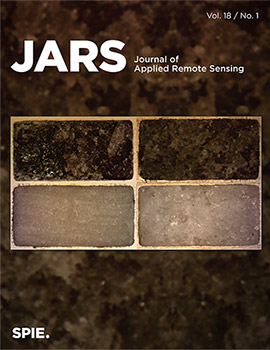Frontiers in Image and Signal Processing for Remote Sensing (July-September 2023)
Guest Editors: Chi Lin and Chang Wu Yu
Meeting the Challenges of Ecosystem Management using Remote Sensing (April-June 2023)
Guest Editors: Manjit Kaur, Raman Singh, and Hassène Gritli
Unmanned Systems and Satellites: A Synergy for Added-Value Possibilities (April-June 2022)
Guest Editors: Panagiotis Partsinevelos and Hongbo Su
Coastal Zone Remote Sensing for Environmental Sustainability (January-March 2022)
Guest Editors: Shuisen Chen, Chandrasekar Nainarpandian, and Ayad M. Fadhil Al-Quraishi
Multitemporal Remote Sensing Data Processing and Applications (October-December 2021)
Guest Editors: Liangpei Zhang, Jocelyn Chanussot, Assefa M. Melesse, and Xinghua Li
Satellite Hyperspectral Remote Sensing: Algorithms and Applications (October-December 2021)
Guest Editors: Kun Tan, Xiuping Jia, and Antonio J. Plaza
Satellite Remote Sensing for Disaster Monitoring and Risk Assessment, Management, and Mitigation (July-September 2021)
Guest Editors: Hung Lung Allen Huang and Mitchell Goldberg
Hyperspectral Remote Sensing and Imaging Spectrometer Design (July-September 2021)
Guest Editors: Shen-En Qian, Robert O. Green, and Antonio J. Plaza
Representation Learning and Big Data Analytics for Remote Sensing (July-September 2020)
Guest Editors: Weifeng Liu, Yicong Zhou, Karen Panetta, and Sos Agaian
Instrument Calibration and Product Validation of GOES-R (July-September 2020)
Guest Editors: Xiangqian Wu, Changyong Cao, Satya Kalluri, and Jaime Daniels
Advances in Remote Sensing for Forest Structure and Functions (April-June 2020)
Guest Editors: Lin (Tony) Cao, Yunsheng Wang, and Hao Tang
CubeSats and NanoSats for Remote Sensing (July-September 2019)
Guest Editors: Thomas Pagano and Charles Norton
Advances in Deep Learning for Hyperspectral Image Analysis and Classification (April-June 2019)
Guest Editors: Masoumeh Zareapoor, Jinchang Ren, Huiyu Zhou, and Wankou Yang
Advances in Remote Sensing for Air Quality Management (October-December 2018)
Guest Editors: Barry Gross, Klaus Schäfer, and Philippe Keckhut
Advances in Agro-Hydrological Remote Sensing for Water Resources Conservation (October-December 2018)
Guest Editors: Antonino Maltese and Christopher M. U. Neale
Optics in Atmospheric Propagation and Adaptive Systems (October-December 2018)
Guest Editors: Karin U. Stein, Szymon Gladysz, Christian Eisele, Vladimir P. Lukin
Recent Advances in Earth Observation Technologies for Agrometeorology and Agroclimatology (April-June 2018)
Guest Editors: Shi-bo Fang, George P. Petropoulos, and Davide Cammarano
Improved Intercalibration of Earth Observation Data (January-March 2018)
Guest Editors: Craig Coburn and Aaron Gerace
Feature and Deep Learning in Remote Sensing Applications (October-December 2017)
Guest Editors: John E. Ball, Derek T. Anderson, Chee Seng Chan
Recent Advances in Geophysical Sensing of the Ocean: Remote and In Situ Methods (July-September 2017)
Guest Editors: Weilin Hou and Robert Arnone
Remote Sensing for Investigating the Coupled Biogeophysical and Biogeochemical Process of Harmful Algal Blooms (January-March 2017)
Guest Editors: Alan Weidemann and Ni-Bin Chang
Sparsity-Driven High Dimensional Remote Sensing Image Processing and Analysis (October-December 2016)
Guest Editors: Xin Huang, Paolo Gamba, and Bormin Huang
Advances in Remote Sensing for Renewable Energy Development: Challenges and Perspectives (2015)
Guest Editors: Yuyu Zhou, Lalit Kumar, and Warren Mabee
Onboard Compression and Processing for Space Data Systems (2015)
Guest Editors: Enrico Magli and Raffaele Vitulli
Management and Analytics of Remotely Sensed Big Data (2015)
Guest Editors: Liangpei Zhang, Qian (Jenny) Du, and Mihai Datcu
Remote Sensing and Sensor Networks for Promoting Agro-Geoinformatics (2014 and 2015)
Guest Editors: Liping Di and Zhengwei Yang
High-Performance Computing in Applied Remote Sensing: Part 3 (2014)
Guest Editors: Bormin Huang, Jiaji Wu, and Yang-Lang Chang
Airborne Hyperspectral Remote Sensing of Urban Environments (2014)
Guest Editors: Qian (Jenny) Du and Paolo Gamba
Progress in Snow Remote Sensing (2014)
Guest Editors: Hongjie Xie, Chunlin Huang, and Tiangang Liang
Advances in Infrared Remote Sensing and Instrumentation (2014)
Guest Editors: Marija Strojnik and Gonzalo Paez
Earth Observation for Global Environmental Change (2014)
Guest Editor: Huadong Guo
Advances in Onboard Payload Data Compression (2013)
Guest Editors: Enrico Magli and Raffaele Vitulli
Advances in Remote Sensing Applications for Locust Habitat Monitoring and Management (2013)
Guest Editors: Ramesh Sivanpillai and Alexandre V. Latchininsky
High-Performance Computing in Applied Remote Sensing: Part 2 (2012)
Guest Editors: Bormin Huang and Antonio Plaza
Advances in Remote Sensing for Monitoring Global Environmental Changes (2012)
Guest Editors: Yuyu Zhou, Qihao Weng, Ni-Bin Chang
High-Performance Computing in Applied Remote Sensing: Part 1 (2011)
Guest Editors: Bormin Huang and Antonio Plaza
Satellite Data Compression (2010)
Guest Editor: Bormin Huang
Remote Sensing for Coupled Natural Systems and Built Environments (2010)
Guest Editor: Ni-Bin Chang
Remote Sensing Applications to Wildland Fire Research in the Eastern United States: Selected Papers from the 2007 EastFIRE Conference - Part 2 (2009)
Guest Editors: John J. Qu and Stephen D. Ambrose
Remote Sensing of the Wenchuan Earthquake (2009)
Guest Editor: Huadong Guo
Remote Sensing Applications to Wildland Fire Research in the Eastern United States: Selected Papers from the 2007 EastFIRE Conference (2008)
Guest Editors: John J. Qu and Stephen D. Ambrose
Aquatic Remote Sensing Applications in Environmental Monitoring and Management (2007)
Guest Editors: Vittorio E. Brando and Stuart Phinn





